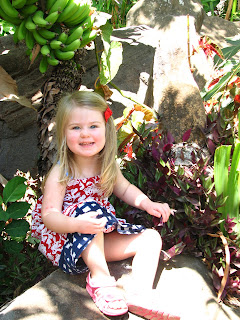During my last few days in El Salvador:
We went to a large park that used to be a coffee plantation. Because people used to work this land, there's a village smack in the middle of this park.
As you can see from the pictures above and to the right, mango season is beginning. I hope that means more delicious mangos in our Logan Bountiful Baskets.
They have a saying here. "Si hay pobres pero no hay hambres." Translation, "There are poor people but there are no hungry people." Very appropriate for a place where food literally falls from the sky. My dad's been hit by a falling mango during mango season. Apparently it hurt.
At the coffee plantation park we found our first non-ghetto play ground. Those are awesome banana trees next to it.
My mother and Kelsey looking cute.
This is how bananas grow on trees. The awkward looking dangling participle is the flower.
The ladies posing in front of banana trees.
The park had a super cool bamboo forest. It just makes you want to snap a bunch of sticks off and take them home. Yeah, good luck with that. Hope you brought your machete. Bamboo is notorious for its non-snap-off-ability, which I was reminded of as I tried feebly to yank some pieces off.
When the wind blows all the bamboo trees sway and creak and click together. It sounds really cool. Therefore, I've posted a video of it, which doesn't do its awesomeness any justice.
My last day there we were able to meet up with our old housekeeper, Loli, who worked for us while we lived in El Sal as a family. I was in first and second grade when I lived here. Loli was very excited to see the grown up me and my mini-me. It was a good visit.
It was interesting to hear about her life. So different than our pampered American lives. She was one of 7 children. Three have died and one has not been heard from since he tried to immigrate to the US (illegally) with the help of a Coyote. Presumably, he didn't survive the extremely treacherous trip. We were the only family Loli worked as a housekeeper for. After that, she sold fresh produce door to door to her clients. She no longer does this because she no longer needs the money to support her children, who have moved out, and her and her husband can live off his pension, which is about 1000 bucks a month. But most importantly, working her vending business is simply too dangerous. Anytime anyone runs any kind of a business in the villages they become prey to the gangs. They will come to you and demand a certain amount of money. If you can't pay up, they will kill your family. Simple as that. The gangs keep everybody down so businesses can't prosper, and people don't work unless they absolutely have to to survive. And we wonder why people risk their lives to come to the United States illegally. Loli's family has received a couple gang threats via phone calls. They call up and say give us your bank account number or we'll kill your family. Her husband, who answered the call, suspected that it was a false threat because the phone number appeared to be coming from Guatemala. He cleverly said, oh, I'm not from this village, I'm from such and such village. The man making the threat said, well, where's that? It became obvious to Loli's husband that they were not going to be found. If the man was a local, the threat would have been real.
P.S. I survived the plane rides home. It was a ridiculously long day but all went well, I didn't kill Kelsey out of tired irritation, and I'm still pregnant. I thoroughly missed El Salvador for the first couple of days back. It's all brown and wintery here, and where are the parrots? Sigh. I guess geese, magpies and a very low homicide rate will have to suffice.














